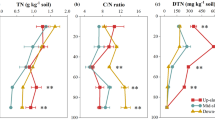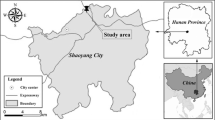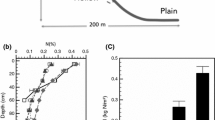Abstract
The net effect of soil erosion by water, as a sink or source of atmospheric carbon dioxide (CO2), is determined by the spatial (re-)distribution and stability of eroded soil organic carbon (SOC), and the dynamic replacement of eroded C by the production of new photosynthate. The depositional position of eroded SOC is a function of the transport distances of soil fractions where the SOC is stored. In theory, the transport distances of soil fractions are related to their settling velocities under given flow conditions. Yet, very few field investigations have been conducted to examine the actual movement of eroded soil fractions along hillslopes, let alone the re-distribution pattern of SOC fractions. Eroding sandy soils and sediment were sampled after a series of rainfall events along a slope on a freshly seeded cropland in Jutland, Denmark. All the soil samples were fractionated into five settling classes using a settling tube apparatus. The spatial distribution of soil settling classes shows a coarsening effect immediately below the eroding slope, followed by a fining trend at the slope tail. These findings support the validity of the conceptual model proposed by Starr et al. (Land Degrad Dev 11:83–91, 2000) to predict SOC redistribution patterns along hillslopes. The δ13C values of soil fractions were more positive at the footslope than on the slope shoulder or at the slope tail, suggesting enhanced decomposition rate of fresh SOC input at the footslope during or after erosion-induced transport. Pronounced CO2 emission rates at the slope tail also suggest a higher potential for decomposition of the eroded SOC after deposition. Overall, our results illustrate that immediate deposition of fast settling soil fractions and the associated SOC at footslopes, and potential CO2 emissions during or immediately after transport, must be appropriately accounted for in attempts to quantify the role of soil erosion in terrestrial C sequestration. A SOC erodibility parameter based on actual settling velocity distribution of eroded fractions is needed to better calibrate soil erosion models.








Similar content being viewed by others
References
Adhikari K, Minasny B, Greve MB, Greve MH (2014) Constructing a soil class map of Denmark based on the FAO legend using digital techniques. Geoderma 214–215:101–113
Aksoy H, Kavvas ML (2005) A review of hillslope and watershed scale erosion and sediment transport models. Catena 64:247–271. doi:10.1016/j.catena.2005.08.008
Alewell C, Meusburger K, Brodbeck M, Bänninger D (2008) Methods to describe and predict soil erosion in mountain regions. Landsc Urban Plan 88:46–53. doi:10.1016/j.landurbplan.2008.08.007
Alewell C, Schaub M, Conen F (2009) A method to detect soil carbon degradation during soil erosion. Biogeosciences 6:2541–2547
Basic F, Kisic I, Nestroy O et al (2002) Particle size distribution (texture) of eroded soil material. J Agron Crop Sci 188:311–322
Berhe AA (2012) Decomposition of organic substrates at eroding vs. depositional landform positions. Plant Soil 350:261–280. doi:10.1007/s11104-011-0902-z
Berhe AA, Kleber M (2013) Erosion, deposition, and the persistence of soil organic matter: mechanistic considerations and problems with terminology: SOM stabilization in eroding landscapes. Earth Surf Process Landf 38:908–912. doi:10.1002/esp.3408
Berhe AA, Harte J, Harden JW, Torn MS (2007) The significance of the erosion-induced terrestrial carbon sink. Bioscience 57:337–346
Berhe AA, Harden JW, Torn MS, Harte J (2008) Linking soil organic matter dynamics and erosion-induced terrestrial carbon sequestration at different landform positions. J Geophys Res Biogeosci. doi:10.1029/2008jg000751
Berhe AA, Suttle KB, Burton SD, Banfield JF (2012) Contingency in the direction and mechanics of soil organic matter responses to increased rainfall. Plant Soil 358:371–383. doi:10.1007/s11104-012-1156-0
Beuselinck L, Govers G, Steegen A, Hairsine PB (1998) Experiments on sediment deposition by overland flow. In: Modelling soil erosion, sediment transport and closely related hydrological processes, vol 249. IAHS Publication, Vienna, pp 91–96
Beuselinck L, Govers G, Steegen A et al (1999) Evaluation of the simple settling theory for predicting sediment deposition by overland flow. Earth Surf Process Landf 24:993–1007
Beuselinck L, Steegen A, Govers G et al (2000) Characteristics of sediment deposits formed by intense rainfall events in small catchments in the Belgian Loam Belt. Geomorphology 32:69–82
Billings SA, Buddemeier RW, de Richter BD, van Oost K, Bohling G (2010) A simple method for estimating the influence of eroding soil profiles on atmospheric CO2. Glob Biogeochem Cycles 24:1–14. doi:10.1029/2009GB003560
Cambardella CA, Elliott ET (1994) Carbon and nitrogen dynamics of soil organic matter fractions from cultivated grassland soils. Soil Sci Soc Am J 58:123–130
Dawson TE, Brooks PD (2001) Fundamentals of stable isotope chemistry and measurement. In: Unkovich MJ, Pate JS, McNeill AM, Gibbs DJ (eds) Application of stable isotope techniques to study biological processes and functioning of ecosystems. Kluwer Academic, Dordrecht, pp 1–18
Dlugoß V, Fiener P, Van Oost K, Schneider K (2012) Model based analysis of lateral and vertical soil carbon fluxes induced by soil redistribution processes in a small agricultural catchment. Earth Surf Process Landf 37:193–208. doi:10.1002/esp.2246
Doetterl S, Six J, Van Wesemael B, Van Oost K (2012a) Carbon cycling in eroding landscapes: geomorphic controls on soil organic C pool composition and C stabilization. Glob Change Biol 18:2218–2232. doi:10.1111/j.1365-2486.2012.02680.x
Doetterl S, Van Oost K, Six J (2012b) Towards constraining the magnitude of global agricultural sediment and soil organic carbon fluxes. Earth Surf Process Landf 37:642–655. doi:10.1002/esp.3198
Doetterl S, Cornelis J-T, Six J et al (2015) Soil redistribution and weathering controlling the fate of geochemical and physical carbon stabilization mechanisms in soils of an eroding landscape. Biogeosciences 12:1357–1371. doi:10.5194/bg-12-1357-2015
Fiener P, Govers G, Oost KV (2008) Evaluation of a dynamic multi-class sediment transport model in a catchment under soil-conservation agriculture. Earth Surf Process Landf 33:1639–1660. doi:10.1002/esp.1634
Fiener P, Dlugoß V, Van Oost K (2015) Erosion-induced carbon redistribution, burial and mineralisation—Is the episodic nature of erosion processes important? Catena 133:282–292. doi:10.1016/j.catena.2015.05.027
Harden JW, Sharpe JM, Parton WJ et al (1999) Dynamic replacement and loss of soil carbon on eroding cropland. Glob Biogeochem Cycles 13:885–901. doi:10.1029/1999GB900061
Heckrath G, Halekoh U, Djurhuus J, Govers G (2006) The effect of tillage direction on soil redistribution by mouldboard ploughing on complex slopes. Soil Tillage Res 88:225–241. doi:10.1016/j.still.2005.06.001
Hu Y, Kuhn NJ (2014) Aggregates reduce transport distance of soil organic carbon: Are our balances correct? Biogeosciences 11:6209–6219. doi:10.5194/bg-11-6209-2014
Hu Y, Kuhn NJ (2016) Erosion-induced exposure of SOC to mineralization in aggregated sediment. Catena 137:517–525. doi:10.1016/j.catena.2015.10.024
Hu Y, Fister W, Rüegg H-R et al (2013) The use of equivalent quartz size and settling tube apparatus to fractionate soil aggregates by settling velocity. In: Geomorphology techniques online edition. British Society for Geomorphology Section-1, London
Jacinthe PA, Lal R (2001) A mass balance approach to assess carbon dioxide evolution during erosional events. Land Degrad Dev 12:329–339. doi:10.1002/ldr.454
Jacinthe PA, Lal R, Kimble JM (2001) Assessing water erosion impacts on soil carbon pools and fluxes. Assessment methods for soil carbon. CRC Press, Boca Raton, pp 427–450
Jacinthe P-A, Lal R, Kimble JM (2002) Carbon dioxide evolution in runoff from simulated rainfall on long-term no-till and plowed soils in southwestern Ohio. Soil Tillage Res 66:23–33
Jacinthe P-A, Lal R, Owens LB, Hothem DL (2004) Transport of labile carbon in runoff as affected by land use and rainfall characteristics. Soil Tillage Res 77:111–123. doi:10.1016/j.still.2003.11.004
Kaiser M, Berhe AA, Sommer M, Kleber M (2012) Application of ultrasound to disperse soil aggregates of high mechanical stability. J Plant Nutr Soil Sci 175:521–526. doi:10.1002/jpln.201200077
King CA (1975) Some comments on the glacial geomorphology of the Viborg area of Jutland, Denmark. Geogr Tidsskr 74:1–11
Kirkels FMSA, Cammeraat LH, Kuhn NJ (2014) The fate of soil organic carbon upon erosion, transport and deposition in agricultural landscapes—a review of different concepts. Geomorphology 226:94–105. doi:10.1016/j.geomorph.2014.07.023
Kuhn NJ (2013) Assessing lateral organic carbon movement in small agricultural catchments. Publ Zur Jahrestag Schweiz Geomorphol Ges Ed Graf C 29:151–164
Kuhn NJ, Yair A (2004) Spatial distribution of surface conditions and runoff generation in small arid watersheds, Zin Valley Badlands, Israel. Geomorphology 57:183–200. doi:10.1016/S0169-555X(03)00102-8
Kuhn NJ, Hoffmann T, Schwanghart W, Dotterweich M (2009) Agricultural soil erosion and global carbon cycle: controversy over? Earth Surf Process Landf 34:1033–1038. doi:10.1002/esp.1796
Lal R (2003) Soil erosion and the global carbon budget. Environ Int 29:437–450. doi:10.1016/S0160-4120(02)00192-7
Lal R, Pimentel D (2008) Soil erosion a carbon sink or source? Science 319:1040–1041
Loch RJ (2001) Settling velocity—a new approach to assessing soil and sediment properties. Comput Electron Agric 31:305–316
Mora JL, Guerra JA, Armas CM et al (2007) Mineralization rate of eroded organic C in Andosols of the Canary Islands. Sci Total Environ 378:143–146. doi:10.1016/j.scitotenv.2007.01.040
Nadeu E, Berhe AA, de Vente J, Boix-Fayos C (2012) Erosion, deposition and replacement of soil organic carbon in Mediterranean catchments: a geomorphological, isotopic and land use change approach. Biogeosciences 9:1099–1111. doi:10.5194/bg-9-1099-2012
NOAA (2015) National Oceanic and Atmospheric Administration, United States Department of Commerce. http://www.noaa.gov/wx.html. Accessed 7 May 2015
Pimentel D, Harvey C, Resosudarmo P et al (1995) Environmental and economic costs of soil erosion and conservation benefits. Science 267:1117–1123
Polyakov VO, Lal R (2004) Soil erosion and carbon dynamics under simulated rainfall. Soil Sci 169:590–599. doi:10.1097/01.ss.0000138414.84427.40
Quinton JN, Govers G, Van Oost K, Bardgett RD (2010) The impact of agricultural soil erosion on biogeochemical cycling. Nat Geosci 3:311–314. doi:10.1038/ngeo838
Robertson GP, Wedin D, Groffmann PM et al (1999) Soil carbon and nitrogen availability—nitrogen mineralization, nitrification, and soil respiration potentials. In: Robertson GP, Coleman DC, Bledsoe CS, Sollins P (eds) Standard soil method for long-term ecological research. Oxford University Press, Oxford
Rummel JD, Beaty DW, Jones MA et al (2014) A new analysis of Mars “Special Regions”: findings of the Second MEPAG Special Regions Science Analysis Group (SR-SAG2). Astrobiology 14:887–968
Six J, Paustian K, Elliott ET, Combrink C (2000) Soil structure and organic matter. I. Distribution of aggregate-size classes and aggregate-associated carbon. Soil Sci Soc Am J 64:681–689. doi:10.2136/sssaj2000.642681x
Six J, Guggenberger G, Paustian K et al (2001) Sources and composition of soil organic matter fractions between and within soil aggregates. Eur J Soil Sci 52:607–618
Six J, Conant RT, Paul EA, Paustian K (2002) Stabilization mechanisms of soil organic matter: implications for C-saturation of soils. Plant Soil 241:155–176
Smith SV, Renwick WH, Buddemeier RW, Crossland CJ (2001) Budgets of soil erosion and deposition for sediments and sedimentary organic carbon across the conterminous United States. Glob Biogeochem Cycles 15:697–707
Stallard RF (1998) Terrestrial sedimentation and the carbon cycle: coupling weathering and erosion to carbon burial. Glob Biogeochem Cycles 12:231–257
Starr GC, Lal R, Malone R et al (2000) Modeling soil carbon transported by water erosion processes. Land Degrad Dev 11:83–91
Tisdall JM, Oades JM (1982) Organic matter and water-stable aggregates in soils. J Soil Sci 33:141–163
Tromp-van Meerveld HJ, Parlange J-Y, Barry DA et al (2008) Influence of sediment settling velocity on mechanistic soil erosion modeling. Water Resour Res. doi:10.1029/2007WR006361
van Hemelryck H, Govers G, Van Oost K, Merckx R (2011) Evaluating the impact of soil redistribution on the in situ mineralization of soil organic carbon. Earth Surf Process Landf 36:427–438. doi:10.1002/esp.2055
Van Oost K, Beuselinck L, Hairsine PB, Govers G (2004a) Spatial evaluation of a multi-class sediment transport and deposition model. Earth Surf Process Landf 29:1027–1044. doi:10.1002/esp.1089
Van Oost K, Govers G, Quine TA, Heckrath G (2004b) Comment on “Managing Soil Carbon” (I). Science 305:1567b. doi:10.1126/science.1100273
Van Oost K, Quine TA, Govers G et al (2007) The impact of agricultural soil erosion on the global carbon cycle. Science 318:626–629. doi:10.1126/science.1145724
Veihe A, Hasholt B, Schiøtz IG (2003) Soil erosion in Denmark: processes and politics. Environ Sci Policy 6:37–50. doi:10.1016/S1462-9011(02)00123-5
Walling DE (1983) The sediment delivery problem. J Hydrol 65:209–237
Walling DE (1988) Erosion and sediment yield research—some recent perspectives. J Hydrol 100:113–141
Wang X, Cammeraat ELH, Romeijn P, Kalbitz K (2014a) Soil organic carbon redistribution by water erosion—the role of CO2 emissions for the carbon budget. PLoS One 9:e96299. doi:10.1371/journal.pone.0096299
Wang Z, Van Oost K, Lang A et al (2014b) The fate of buried organic carbon in colluvial soils: a long-term perspective. Biogeosciences 11:873–883. doi:10.5194/bg-11-873-2014
Warrington DN, Mamedov AI, Bhardwaj AK, Levy GJ (2009) Primary particle size distribution of eroded material affected by degree of aggregate slaking and seal development. Eur J Soil Sci 60:84–93. doi:10.1111/j.1365-2389.2008.01090.x
Xiao L, Hu Y, Greenwood P, Kuhn NJ (2015) The use of a raindrop aggregate destruction device to evaluate sediment and soil organic carbon transport. Geogr Helv 70:167–174. doi:10.5194/gh-70-167-2015
Zibilske LM (1994) Carbon mineralization. Soil Science Society of America, Madison, pp 835–863
Acknowledgments
We gratefully acknowledge the financial support granted by Freiwillige Akademische Gesellschaft (FAG) Basel, the University of Basel, Switzerland, and the University of California Merced. The contributions of Ruth Strunk and Miriam Widmer in carrying out the laboratory experiments are also gratefully acknowledged. We particularly appreciate the generous support of Dr. Christina Bradley and Mr. David Araiza from UC Merced for their help with stable isotope measurements; and members of the Berhe Soil Biogeochemistry Lab at UC Merced for assistance with different aspects related to lab work. The draft of the manuscript was substantially improved by comments from Florence Greenwood.
Author information
Authors and Affiliations
Corresponding author
Additional information
Responsible Editor: John Harrison.
Rights and permissions
About this article
Cite this article
Hu, Y., Berhe, A.A., Fogel, M.L. et al. Transport-distance specific SOC distribution: Does it skew erosion induced C fluxes?. Biogeochemistry 128, 339–351 (2016). https://doi.org/10.1007/s10533-016-0211-y
Received:
Accepted:
Published:
Issue Date:
DOI: https://doi.org/10.1007/s10533-016-0211-y




